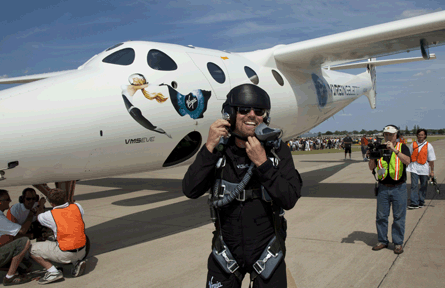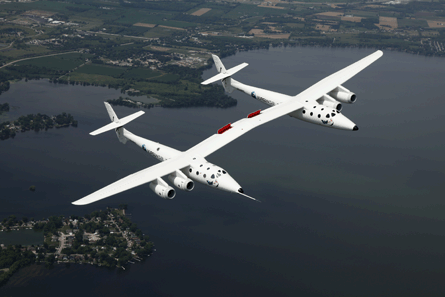Sir Richard Branson has never been afraid of a challenge. The high-profile British billionaire - who started his first business venture as a schoolboy - launched his airline Virgin Atlantic in the face of first scorn from its rival British Airways and then a concerted attempt to force the usurper on its lucrative transatlantic routes out of the skies. By the 1990s it had become one of the most admired long-haul carriers in the world.
Branson's sprawling interests today include everything from personal finance to trains, hotels, mobile communications, fuels and soft drinks. Many of the businesses are joint ventures, with Branson in effect licensing his world-famous brand and his skills for self-publicity. An ideas man and strategist, rather than a micro-manager, he tends to entrust the day-to-day running of his concerns to lieutenants.
 |
|---|
© Virgin Galactic |
However, one business especially close to his heart is Virgin Galactic. Branson is determined to bring sub-orbital space travel if not to the masses, then at least to wealthy adventurers. Although the Russians began offering trips into space 10 years ago, with American Dennis Tito the first "civilian" to visit the International Space Station in 2001, this has only been open to the super-rich. Branson is offering 2h trips on his rocket, SpaceShipTwo for just $200,000, offering a free-floating, out of seat zero g experience and "out of this world" views of the Earth at an apogee of 110km for not much more than people might pay for a state room on a luxury cruise or chartering a Boeing Business Jet.
So far, Virgin Galactic has received about 300 deposits and hopes to be begin the service within two years of the first SpaceShipTwo test flight at the company's spaceport in New Mexico planned around the turn of the year. WhiteKnightTwo - the double-hulled, all-composite "mother ship" that will carry the business jet-sized rocket into sub-orbit - is currently in flight test and made its public flying debut at the EAA AirVenture show at Oshkosh in August, carrying a flight-suited Branson.
Virgin Galactic has its origins in SpaceShipOne, a concept developed by Scaled Composites founder Burt Rutan and funded by Microsoft founder Paul Allen that won the Ansari X prize in 2004 and flew into space three times that year. Branson had registered the Virgin Galactic brand back in the late 1990s with a vision to one day develop a "spaceline". Branson and Rutan teamed up to form the SpaceShip Company - which was contracted to build three WhiteKnightTwos and five SpaceShipTwos.
The WhiteKnightTwo carrier ship releases SpaceShipTwo at around 50,000ft and the six-passenger rocket flow by two pilots then continues its trip under its own power.
Also at Oshkosh, Branson signed a $280 million deal with Abu Dhabi investment company Aabar that will give it a 32% stake in Virgin Galactic and fund the development of a satellite-carrying capability on WhiteKnightTwo. Virgin Galactic expects that eventually half its revenues will come from cargo and the scientific community.
Speaking after his flight, Branson said: "This has been one of the most incredible experiences of my life. It's a beautiful aircraft to fly and its incredibly light carbon construction and efficient design points the way to a much brighter future for commercial aviation as well as the industrial revolution in space which I believe our entire space launch system heralds."
 |
|---|
© Virgin Galactic |
Branson follows a tradition of dashing English adventurers in the mould of the early aviators, who funded their own projects and by force of personality generated publicity. But while many of them were from monied families, Branson is, despite his genius at hype and laid-back, long-haired appearance, a hard-nosed businessman with a knack for making the right investments.
Although his Virgin Galactic venture is rooted in romanticism about taking aviation to a new level, Branson firmly believes that this will be a highly profitable business carrying as many as 50,000 passengers in its first decade of operation, and changing these space tourists' view of the world forever.
FINALISTS
- Airbus ROW/ROP team
The Airbus A380 development programme spawned several spin-offs, one of the most important a runway overrun prevention system - known as ROW/ROP and now undergoing certification. It allows a crew, once they know the runway they will be landing on, to pre-select an exit and minimise time spent on the runway. ROW/ROP uses satellite navigation and a terrain database to provide real-time knowledge of the aircraft position and brake automatically. Airbus experimental test pilot Captain Armand Jacob says the system is invaluable when visibility is limited or when undertaking land-and-hold-short operations.
- Gary Scott
Bombardier's commercial aircraft president has had to battle scepticism from rivals and analysts, internal hurdles and a global financial crisis to launch the Canadian manufacturer into the mainline airline market with the 110/130-seat CSeries family. With confirmed orders earlier this year from Lufthansa and Irish lessor LCI, the Pratt & Whitney PW1000G-powered CSeries - which will enter service in 2013 - will be the first aircraft in many years to compete with the lower end of the Airbus and Boeing product range. Downturn notwithstanding, Scott is sure Bombardier can secure further orders this year.
- Bob Saia's Pratt & Whitney PurePower team
The development team headed by Bob Saia flew P&W's newest product - previously known as the geared turbofan - for the first time last year. The powerplant, selected by Bombardier and Mitsubishi for their next-generation airliners and due to enter service in 2013, uses a reduction gear box to disconnect fan from turbine. This allows each component to turn at optimum speed. Because the small turbine can revolve quickly while driving a much larger fan slowly, this delivers "dramatic decreases in fuel consumption and emissions" with fuel burn reduced by more than 15%.
Source: Flight Daily News


























